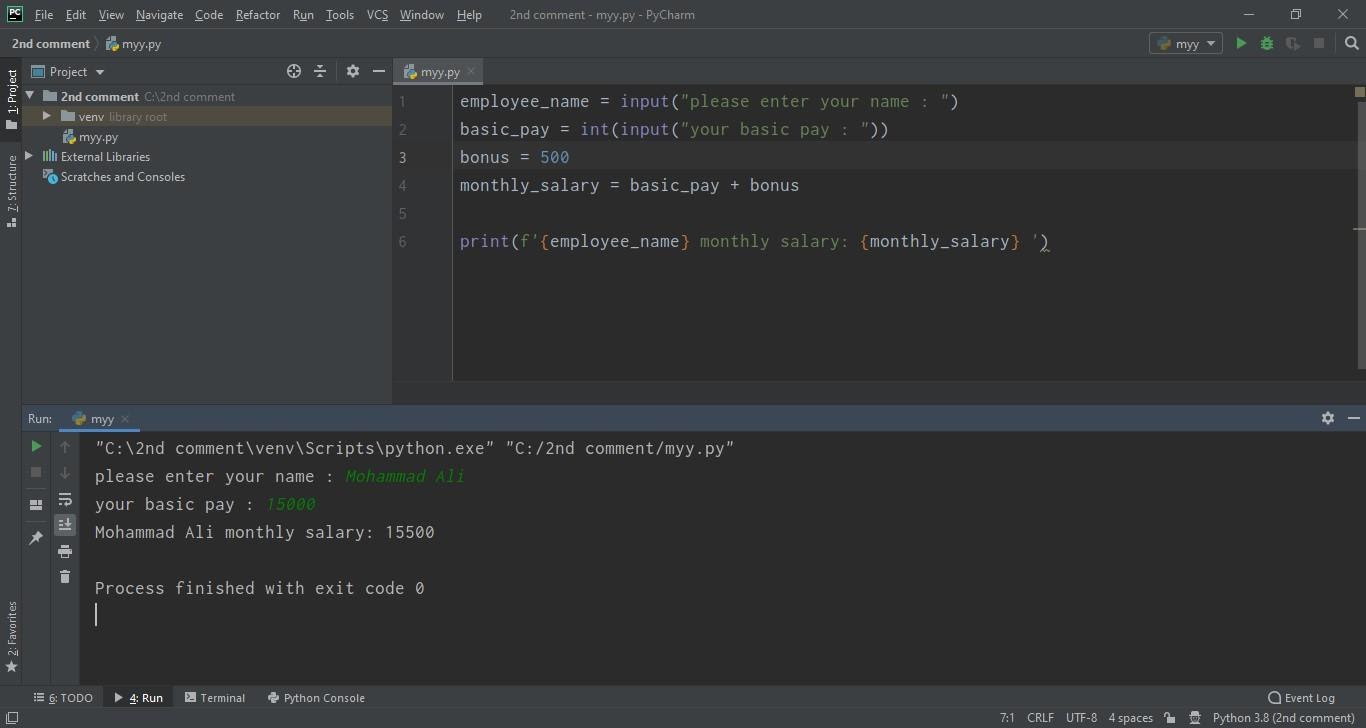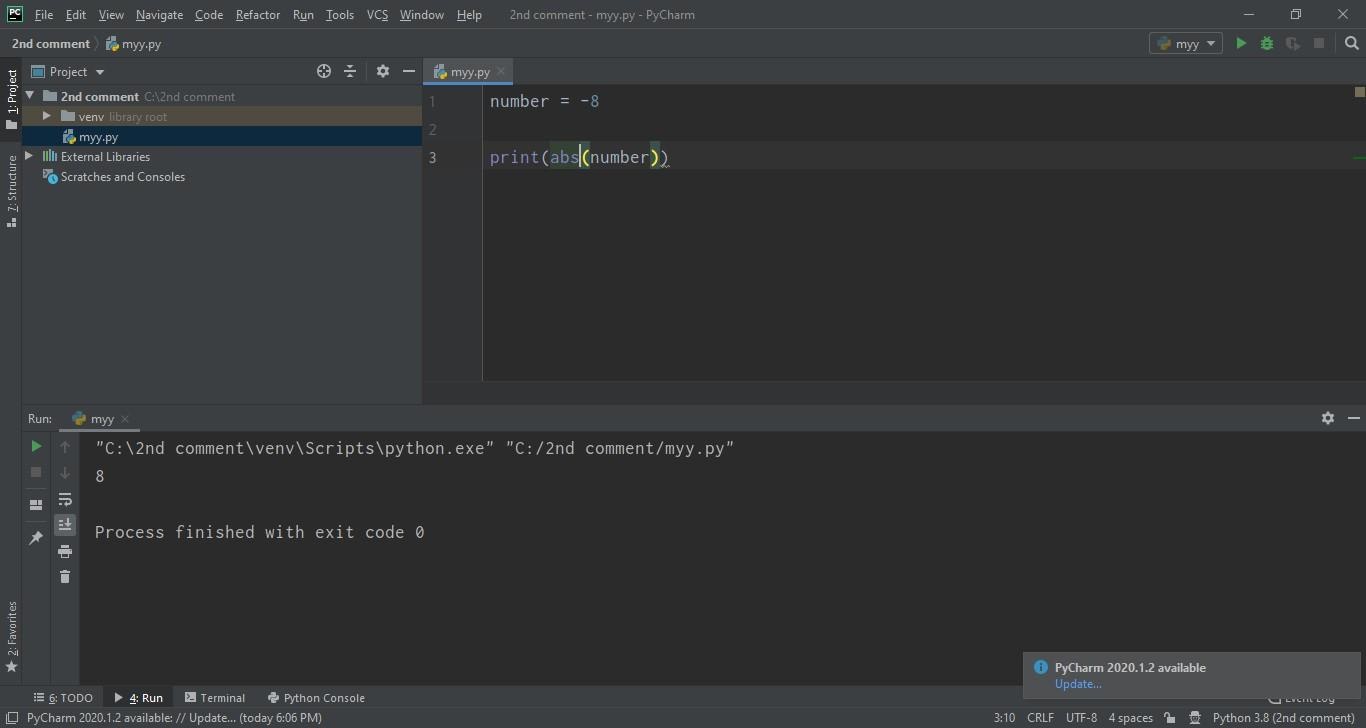
We will first have a look at the arithmetic operators and after that, we also discuss different builtin arithmetic functions in Python Math module. So, let’s get started:
Arithmetic Operators in Python
- Arithmetic operators ( +, -, *, /, ^ etc. ) are used to perform simple arithmetic operations in python.
- So, let’s open up your PyCharm and perform a simple task using these operators, as shown in below figure:
- I used a single star for multiplication and a double star for the square power.
- It is showing the results of the operations, which it is performing respectively.
Now let’s design a simple calculator using these arithmetic operators but before that let’s have a look at How to take input from user in python.
Getting Input from users in Python
- If we want to work dynamically, we will learn how we get values from users.
- It quite simple in python, you will just need to use an input method here.
- It will take input from the user and store it in the assigned variable.
- If you want to take the full name, age, and qualification of the player, you will write it as shown in the image:
Now I will talk about type conversion and we will make a simple program that will calculate the salary of an employee so that we can learn to perform basic calculations:
Type conversion in Python
In this part, I will tell you, what is Type Conversion in Python? And why it is required? Let’s follow the step.
- Suppose we want to count the salary of an employee. See the steps in the image.
- Here I put int. before the fourth string, which is basic pay, but I have put the bonus in the whole numbers and it will be unable to do the concatenation because it is allowing it as a string. So, I typed the data and run it, see the results.
- You can also use the second method as you can put int. where you are performing calculations, as shown in the image.
- You can convert it by using three major data types i.e. int, float, string.
Simple Calculator in Python
Now we will design a simple calculator in which the user will enter 1st & 2nd number and our code will perform these operations with those operators like addition, subtraction, division, and multiplications. I typed the following strings below:
- first_number = float(input(“Enter first number : “))
- second_number = float(input(“Enter second number : “))
- print(“All Arithmetic Operations are as under.”)
- print(first_number + second_number)
- print(first_number – second_number)
- print(first_number * second_number)
- print(first_number / second_number)
- print(first_number ** second_number)
- I converted the type of first and second strings.
- Run the program
- You can see in the printed screen all the arithmetic operations are performed respectively.
- All the values are in floating points because we converted it into the float.
- You can also convert it in integer and check it.
- I wrote 9 and 5 and enter it, results are shown in above figure.
Operator Precedence in Python
Let’s suppose, we have a variable here.
- Profit = 15 + 30 * 25
- Now let’s print it using: print(profit)
- Run the program.
- The answer will be 765 in the output window.
Python follows the standard order of precedence. First, it will perform multiplication and then it will perform the addition. However, we can change the order using parenthesis.
- Suppose, we want to operate the addition method first.
- So, I will place parenthesis before and after both terms.
- Then it will perform the addition method first then multiplication.
- I will write it as:
profit = (15 + 30) * 25
- Run the program and answer will be 1125.
Now I will expand the equation and will do subtraction with it, let’s see what happens.
profit = (15 + 30) * 25 – 10
- Run the program and answer will be 1115.
- If we add parenthesis to it as:
profit = (15 + 30) * (25 – 10)
- Run the program and we will get 675.
Numbers and Importing Math’s Function in Python
In this part of the lecture, I will discuss predefined functions about numbers in Python and I will also show you, how to import math modules for the advanced predefined function and methods, predefined for numbers. So let’s get started.
round()
- Suppose we have a variable as, number = 3.7.
- I want easily round it using:
print(round(number))
- Run the program and it will round the figure to 4.
abs()
- Suppose I have negative value -8 and I want to find the absolute value of it.
- I will use abs() and it It will return 8, as shown in below figure:
min()
- If I want to find the minimum value among the two numbers. I will write it as:
print(min(9, 4.5)
- It will return the minimum value as, 4.5.
max()
- You can do the exact opposite of min, if you want to find out the maximum value among the two numbers.
print(max(9, 4.5)
pow()
- If I want to calculate the multiples of itself i.e. square, cube etc. then I will write it as:
print(pow(5, 3)
- The first number will be base and the second one will be the power.
- Run the program & it will show the answer, 125.
Import a Math Module in Python
Now let’s have a look at How to import a math module in python code:
- Python Math library has a lot of builtin functions, which we can easily import by writing this statement at the top of our code.
from Math import *
- By writing this statement we are simply saying that get access to all the functions of Math Library.
Now, let’s have a look at few of its functions:
sqrt()
- Suppose I want to take the square root of number = 72
- I write it as
print (sqrt(number))
- Run the program and it will return as 8.4 something, as shown in below figure:
Here’s the complete list of functions in Python Math Module:
| Function | Description |
|---|---|
| ceil(x) | It returns the previous integer value. |
| copysign(x, y) | It will assign sign of y to x. |
| fabs(x) | It returns the absolute value. |
| factorial(x) | It returns the factorial value. |
| floor(x) | It returns the next integer value. |
| fmod(x, y) | It divides x by y and returns the remainder. |
| frexp(x) | It returns the mantissa and exponent as pair value. |
| fsum(iterable) | It returns an accurate floating point sum of values in the iterable |
| isfinite(x) | It returns TRUE, if the number is finite i.e. neither infinite nor NaN. |
| isinf(x) | It returns TRUE, if the number is infinite. |
| isnan(x) | It returns TRUE, if the number is NAN. |
| ldexp(x, i) | It returns x * (2**i). |
| modf(x) | It returns the fractional and integer values. |
| trunc(x) | It returns the truncated integer value. |
| exp(x) | It returns e**x |
| expm1(x) | It returns e**x – 1 |
| log(x[, base]) | It returns the logarithmic value to the base e. |
| log1p(x) | It returns the natural logarithmic value of 1+x. |
| log2(x) | It returns the base-2 logarithmic value. |
| log10(x) | It returns the base-10 logarithmic value. |
| pow(x, y) | It returns x raised to the power y. |
| sqrt(x) | It returns the square root of x. |
| acos(x) | It returns the arc cosine of x. |
| asin(x) | Returns the arc sine of x. |
| atan(x) | Returns the arc tangent of x. |
| atan2(y, x) | Returns atan(y / x) |
| cos(x) | Returns the cosine of x |
| hypot(x, y) | Returns the Euclidean norm, sqrt(x*x + y*y) |
| sin(x) | Returns the sine of x |
| tan(x) | Returns the tangent of x |
| degrees(x) | Converts angle x from radians to degrees |
| radians(x) | Converts angle x from degrees to radians |
| acosh(x) | Returns the inverse hyperbolic cosine of x |
| asinh(x) | Returns the inverse hyperbolic sine of x |
| atanh(x) | Returns the inverse hyperbolic tangent of x |
| cosh(x) | Returns the hyperbolic cosine of x |
| sinh(x) | Returns the hyperbolic cosine of x |
| tanh(x) | Returns the hyperbolic tangent of x |
| erf(x) | Returns the error function at x |
| erfc(x) | Returns the complementary error function at x |
| gamma(x) | Returns the Gamma function at x |
| lgamma(x) | Returns the natural logarithm of the absolute value of the Gamma function at x |
| pi | Mathematical constant, the ratio of circumference of a circle to it’s diameter (3.14159…) |
| e | mathematical constant e (2.71828…) |
So that was all about arithmetic operators in Python. I hope now you got the clear idea of how powerful python is. So, that was all for today. In the next lecture, we will have a look at How to create IF Loop in Python. Till then take care and have fun !!! 
The post How to use Arithmetic Operators in Python appeared first on The Engineering Projects.





No comments:
Post a Comment